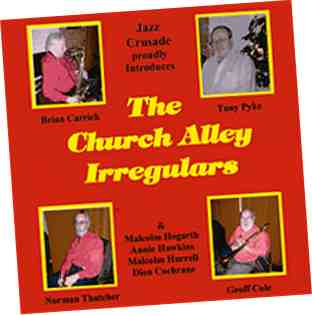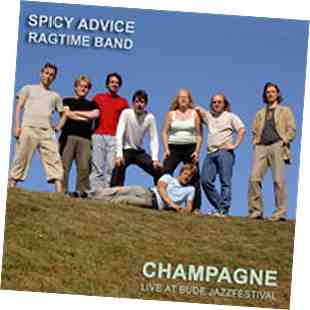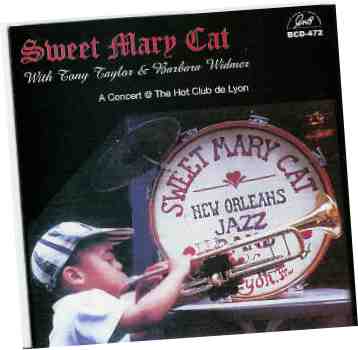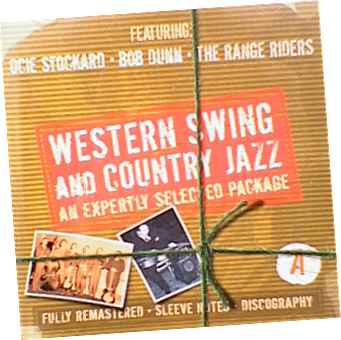
| Gimme some of that hot stuff! | ||||||||||
New Orleans jazz reviews
We spin dusty disks and, after dancing embarrassingly, we write about them.
Page 1.
![]()
Once upon a time the eccentric pooter on many musical instruments known, unknown, and invented, blind virtuoso Rahsaan Roland Kirk, paused in his weird and wayward programme to call out to the audience, 'Shall we go to New Orleans? New Orleans? Shall we go to New Orleans?' The answer was a resounding 'Yes'.
The moment Kirk and his romping pianist took off on 'Red Beans and Rice' the atmosphere was charged with magical, electric meaning - light, vigour, joy. The astonished populace began to clap, shout, and cheer. These patient and polite pupils had realised with a sense of awakening into sunshine that they were actually enjoying themselves: 'We're alive! The whole world's alive! Music lives! Yippee!' This event is recorded on the CD 'Bright Moments'. It was certainly a bright moment.
So why is it that newspapers and radio report on the concerts of modernist musicians tootling interminably in front of a backing group as if this activity were of serious concern to mankind, and totally ignore the festivals of what is misleadingly called 'traditional jazz' which proliferate all over the U.K. and are attended by thousands of normal citizens in places as far apart as Bude, Keswick and Kirkcudbright?
The answer is obvious. Fashion. Jazz in the New Orleans tradition is regarded as dated, doted, long gone. So why is it still popular and still developing in Britain, Sweden, Denmark, Holland, France? Why are there so many specialist record companies reissuing material from the 1920s right through to CDs of the best bands working today? The contemporary players are not all elderly survivors of the Forties and Fifties Jazz Revival, but often men and women in their twenties and thirties rejoicing in the discovery of shared improvisation. I'll mention some of these record companies so that anyone interested can make a search: Classics Records; Timeless; Timeless Historical; Storyville; Frog; PEK Sound; Upbeat; Lake Records; Stomp Off; Good Time Jazz: 504. (See the Crazy Jazz website for more info)
Special mention, too, for the American label Jazz Crusade, run by Big Bill Bissonnette, whose website would repay a visit. Big Bill set out to record the best New Orleans musicians alive and kicking inside and outside their native place, together with American, British, Swedish, French, Danish enthusiasts who both play at home and tour the globe.
One of Big Bill's noblest enterprises was to put on record everything he could find of the driving, dancing, alto saxophonist 'Captain' John Handy, playing with any band that could keep up with him. Big Bill also recorded the brilliant British clarinetists Brian Carrick and Sammy Rimington with their own bands, with Big Bill's 'Easy Riders', and with New Orleans players both in Europe and America.
![]()
So let's start with a review of one of his latest issues:
The Church Alley Irregulars. Jazz Crusade JCCD-3098.

Norman Thatcher (trumpet);
Geoff Cole (trombone);
Brian Carrick (clarinet and tenor sax);
Tony Pyke (clarinet and alto sax);
Malcolm Hogarth (piano);
Malcolm Hurrell (banjo);
Annie Hawkins (bass);
Dion Cochrane (drums).
Most of these British musicians have been band leaders in their own right, but never before played in combination with each other. None are in the first flush of youth but their enthusiasm remains awesome. To play New Orleans jazz requires not only formidable skill and subtlety but a sixth sense which enables the creation of a harmonic whole by individual improvisers working with variations on and creative departures from a given and recognisable melody. What melodies? Hymns, traditional songs, spirituals, pop tunes, blues, jazz standards, inventions, anything that takes their fancy. As Jelly Roll Morton said 'Jazz isn't what you play, it's how you play it.'
The resulting sessions provide a remarkable atmosphere of vigour, modesty and resourcefulness, so that of the fourteen numbers used as a basis for co-operative creation, only the last two tracks are not entirely successful.
Big Bill describes the musicians as 'a bunch of likeable curmudgeons'. On this CD music makes comrades of them all. If you don't think that 'tact' is the most eloquent quality required by jazz, try this CD.
The curmudgeons start off with a burst of good cheer in 'I Want to be Happy', and they sound it. That doesn't means this is seaside bandstand entertainment. The pianist has outstanding lift, and the two reed players combine with a sensitive dexterity which takes them into the realm of extra-sensory perception.
They can hear themselves and each other at the same time, and adjust accordingly.The trumpeter tends to overuse short sharp bursts of the kind favoured by the late Bunk Johnson, and is often harsh in tone, but on the second number 'Sweet Sue' his muted solo is - well, simply beautiful. Muted trumpet with only strong bass accompaniment is unusual and beguiling, especially when the bass player is the astonishing Annie Hawkins.
The curmudgeons regularly manage a rousing climax with zest, bounce and wit.
I won't go through each track, but commend the delicate cohesion of the clarinet/saxophone duet on 'Beautiful Ohio,' and relish the booting tenor of Brian Carrick when set free on 'Move the Body Over'. There are several tracks which make it impossible not to move about with a smile on your face. Try to sit stony- visaged and still while listening to either of the adventures mentioned above.
This would be a useful CD to introduce anyone to the more civilised joys of genuine contemporary jazz.
The numbers recorded are:
I Want to be Happy
Sweet Sue
May the Circle be Unbroken
My Melancholy Baby
Them There Eyes
Beautiful Ohio
Dallas Blues
Move the Body Over
Magic is the Moonlight
Saint Louis Blues
Alabama Bound
Gatemouth
Church Alley Blues
China BoyJBP, February 2005
![]()
Jensen's New Orleans Jazz Serenaders, at the Keswick Festival, 2004: PEK Sound PKCD-259
Brian Carrick (Clarinet, tenor sax)
Kurt Jensen (Clarinet, tenorsax)
Eddie Bruhner (trumpet)
Nina Ehrenstrale (banjo,vocals)
Nan Ehrenstrale (string bass)
Ronald Andersen (drums)
This line-up is thoroughly cosmopolitan, and all the better for it. Kurt Jensen is Danish, Nan his Swedish wife, and Nina their daughter; Eddie Bruhner is Swedish, Ronald Andersen Danish, and Brian Carrick an English guest bearing gifts.
An intriguing feature of the group is that there's neither trombone nor piano involved, and the two players of clarinet and tenor sax not only complement one another, but engage in all sorts of duets ranging from two saxes playing together and two clarinets playing together to different combinations of sax and clarinet. This gives us a variety of tones, harmonies, puzzles and surprises. Carrick's clarinet is sweet and lively with twirls and embroideries, Jensen's robust; Carrick's tenor bounces and drives, Jensen's is rough, and honks.
What's more, Nina is a singer with a clear, pleasant voice and an unassuming directness which makes the hymn 'How Great Thou Art' more moving than any church could manage, while 'The Cat's Got Kittens' carries sunshine, and the sentimental 'On a Coconut Island' has a freshness and sincerity which would cause the Grump of the Year to blow his nose with embarrassment because he couldn't help liking it.
Tunes:
Get me out of Here
On a Coconut Island
Hindustan
How Great Thou Art
Jambalaya
I Can't Escape from You
Corrine Corrina
Nyboder's Pris
Cat's Got Kittens
Crazy
South
The Old Spinning Wheel
Down by the Riverside
Joe Avery's Piece.
JBP, March 2005
![]()
Sweet Mary Cat - Concert at the Hot Club de Lyon. GHB Records; GHB BCD-472
Christian Guerin (trumpet)
Jean-Pierre Alessi (tenor sax)
Patrick Mollon (trombone)
Fredrick Espinoux (Clarinet)
Barbara Widmer (piano)
Catherine Gerdil (banjo)
Dominic Mollon (bass 1-4)
Tony Taylor (bass 5-10)
Marie Dandrieux (drums)The 2002 Jazz Crusade CD of Sweet Mary Cat contained only three of these musicians (Guerin,Dandrieux,Alessi) topped up by Big Bill and friends, and was oddly sweet, haunting, and infectious - jazz with a woman's touch, exemplified by Marie singing 'After the Ball' with serious, gentle, amateurish charm.
The present group is again multi-national but the tone, instead of being light and lyrical, comes through as routine 'trad jazz' without the joyous surprises of the best bands of today. Of the two British imports (from Switzerland) Barbara Widmer is a strong, load-bearing pianist, but Tony Taylor sings, and shouldn't. 'It Feels Good' has lots of lift and drive and is fun, but - oh well, there it is.
Verdict: disappointing.
Tunes:
Washington and Lee Swing
I Get the Blues
June Night
Abide with Me
It Feels So Good
Bogalusa Strut
Dream
On a Coconut Island
Just a Closer Walk with Thee
Climax Rag
JBP March 2005
![]()
Spicy Advice Ragtime Band - Champagne. P.E.K.Sound PKCD-236

Live at Bude Festival 2003
Personnel:
Joakim Falk(cornet);
Cissie Larsson(clarinet,vocal);
Adam Falk(clarinet/tenor sax);
Hakan Persson(trombone);
Joel Lindberg(piano);
Arvid Sjolander(banjo);
Andreas Gabrielsson(double bass);
Claes-Goran KarIsson(drums).
This is a confident and accomplished Scandinavian band, and contrary to received opinion that traditional New Orleans style groups are composed of grizzled dodderers in funny hats, the musicians here assembled range from their late twenties to early forties, are filled with youthful energy and enthusiasm, hatless and wearing trousers.
They know their jazz history, have a penchant for rags - which are notoriously difficult to drive and levitate - and their research has discovered ones that fit their style. Cissi Larsson sings like Sophie Tucker, which is a mighty rare phenomenon nowadays, and the men wisely avoid trespassing on her vocal territory. All hands play with zest and taste, bringing most of the tunes to a suitable pitch of controlled vigour. The pianist, Joel Lindberg, is particularly deft and sprightly, while the tenor sax provides a sustained lift and subtelty which gave joy to an ageing heart. 'Tie Me To Your Apron Strings' and 'Lou-easy-an-ia' have an easy-riding charm based on swiftly moving interchange at once spontaneous and artful, and throughout their repertoire the whole band travels with infectious swing. Well worth the small investment needed.
Tunes:
Creole Belles;
Golfing Papa;Smiles;
Champagne Rag;
Heebie Jeebies;
Tie Me to Your Apron Strings Again;
St Philip Street Breakdown;
You've Got the Right Key but the Wrong Keyhole;
Each Day;
Georgia Camp Meeting;
My Special Friend is Back in Town;
Peacherine Rag;
Lou-easy-an-ia;
In the Sweet Bye and Bye;
Aggravtin' Papa;
When My Dreamboat Comes Home.Visit the Spicy Advice Web-site where you can download some clips.
JBP April 2005.
![]()
Western Swing and Country Jazz. JSP Records: JSP7742A.B.C.D.2005
Personnel:
Many and various.
Jazz is a language with a wild variety of dialects, some of them forgotten. With the advent of CDs, intrepid explorers penetrated the dungeons of dead, dazed or amnesiac record companies and disinterred these dialects, to restore their exponents in remastered form to living air However long ago the original recordings were made, the musicians are dead no longer.
In the year 2000 ASV Living Era produced a single CD of 'Western Swing', subtitled 'Hot Hillbilly Jazz and Blues.' Now here comes a bumper crop of 4 CDs in one package from JSP, bringing home a whole world of unique, exuberant jazz. Four bands reappear from the earlier offering, with many extra tracks, and four more bands are added.
The music was recorded in Dallas, San Antonio and Memphis between 1935 and 1939, in the midst of the Big Band era, to which these groups pay no attention. The players range in number from five to eight , and the flavour is a remarkable amalgam of country music, driving jazz, mountain fiddle, commercial songs, sentimental ditties, blues and jazz standards. Dallas Blues, Dinah, Sister Kate, Trouble in Mind can be followed by My Untrue Cowgirl, Long Long Ago, My Little Girl, or Big Bill Broonzy's Skoodle de Doo. But only on CD number C is there a shortage of all-out jazz.
You can be reminded of Jimmie Rodgers with the Louisville Jug Band, Cajun music, Blind Blake, or on one occasion Fats Waller and His Rhythm, and there's even an imitation of Louis Armstrong singing Black and Blue. But don't let this mislead you. These bands are working their own territory in their own way and the drive and sheer bottle of the swing they produce can be inspiriting and infectious.
Their instrumentation is unique. Basically they are string bands - always a fiddle, sometimes two; always a bass, and since they rarely use drums the bass work is ferocious; electric guitar and even an electric mandolin; accordion, acoustic guitar and sometimes a banjo. Into these outfits are imported by most bands an outright blazing jazz player either on trumpet, cornet, clarinet or saxophone. A rollicking piano bounces things along.
On CD A, a remarkable trumpeter named Harry Palmer storms through every type of number, whether brassy, growling, delicate or brash according to requirements. I can't understand why he didn't become more widely known.
There's a lot of singing, usually fresh and accomplished, sometimes astonishing us with dexterous pyrotechnics or scat vocals of weird eccentricity.
These boys don't care what other traditions make of them, they use what they want from wherever, and blaze away with elastic bounce, metallic jump and thumping swing. Their boisterous enthusiasm is tonic. Try it.
JBP. April 2005
![]()
Sarah Spencer.
Sarah Spencer is a robust, adroit and intelligent saxophone player. She was born in England, now lives in New York and can be found on CD as Sarah Bissonnette when married to Big Bill and as Sarah Spencer when unmarried to Big Bill. Under both guises she bounces with determined aplomb, elevating or bringing down to earth any band she is in according to its deserts. She gives soloists a solid backing with admirable zest and tact, a combination rare and devoutly to be wished. Her own solos have drive and lift to satisfy the heart, occasionally soaring and rocking like Captain John Handy, a dangerous but alluring mentor.
Sarah can be found in excellent form on Does Jesus Care? Jazz Crusade JCCD3011, when she delivers a rousing commentary on Sammy Rimmington's pure and lucid clarinet (unfortunately it's the only track on which she figures). But she is allowed to rule the roost, choosing tunes and players on the CD Sarah Spencer's Down Home Gang PEK Sound PKCD141, recorded in Devon in 1999.
It's terrific.
JBP May 2005.
![]()
The Very Best of the Temperance Seven. EMI Gold. 2004
If you turn over any Jazz CD reissued by a British company Frog, Timeless, Retrieval, Collector's Classics, or Etcetera - ordering music from the nine teen-twenties or thirties, - I'll be surprised if you don't see in modest print towards the bottom of the space available, a legend which runs 'remastered by John R.T. Davies'. Indeed, many of the records themselves probably came from John R.T's own collection.
Well, he died in March of this year, regretted by all those who love Jazz from the classic era. John R.T. was so preposterously adept at producing live fresh music from old cracked 78s lying ashamed of themselves in some dusty corner that we can't do without him but will have to.
That's not all. He was a scholar of the music, a tireless discographer who contributed regularly to the sadly deceased journal STORYVILLE, and himself a highly sophisticated player of trombone and alto sax (an unusal combination) as well as enjoying outings on Adrian Rollini's favourite eccentricities the hot fountain pen and the goofus.
He was born in 1927 and during the nineteen fifties played with the traditional Jazz bands of Mick Mulligan, Sandy Brown, Cy Laurie and Acker Bilk.
From 1959 to 1968 he shone as a leading light in the unique outfit known as the Temperance Seven (no doubt because it had nine members), a band originally formed by students at the Royal College of Art who loved the music of the Twenties but were weary of those traditional bands which played the same standards over and over again, apparently in the belief that nothing should change if they could help it. The Temperance Seven wanted fun, and they wanted to be different. The result was an odd and quirky group of highly skilled musicians specialising in surprises. They operated under extravagant assumed names and employed humorous artifice in their arrangements and effects. In 1961, probably to their astonishment, they hit a target at which they had not been aiming when their fresh and felicitous version of You're Driving Me Crazy reached No.1 on the Charts. Mind you, they were at the time under the expert guidance of George Martin at Parlophone, a mentor notoriously expert at providing exactly what the public didn't know they wanted at the time. The Seven remained popular for some years, reappearing occasionally in the Charts without elbowing the rock bands and balladeers away from the jackpot.
To come to the point, EMI Gold have recently reissued a CD entitled The Very Best of the Temperance Seven. I'm not sure it is the very best, but it does demonstrate their deftness of foot and lightness of heart, as well as their accomplished musicianship.
The trouble is that if you are aiming to be odd, quirky and surprising the more regularly you surprise the less surprising it becomes. I sometimes wish they had thrown calculation to the winds and let themselves go in a burst of liberated, authentic Jazz, but they did after all know their own business. As far as this CD is concerned, the real stuff can be found in Driving Me Crazy itself, in Hard-Hearted Hannah and above all in Seven and Eleven. They can play, these boys, and still bring joy on dark days .
The CD should be seen as a tribute to John R.T.Davies, whose alto playing is superb and whose contribution to the survival of our music is the result of meticulous expertise and long and serious devotion.
JBP June 2005
![]()
Brian Carrick's Algiers Stompers: True (I'm Just Crazy Over You). P.E.K.Sound. PKCD-273.

Peter Wright, cornet.
Brian Carrick, clarinet and tenor sax.
Chas Hudson, trombone.
Gabriele Gad, piano.
Malcolm Hurrell, banjo.
Bill Cole, bass.
Guy Fenton, drums.
(Recorded live at Bude Festival 2004).
Brian Carrick's band is one of the most accomplished on the Festival circuit, with a unique style and repertoire, They don't just give us the usual jazz standards, but a varied diet including tunes resurrected from well-stocked memories or forgotten disks. Some are sentimental, but don't let that put you off. They play lessons in how to make jazz from whatever comes to mind at the moment. They don't send the tunes up or blow them away with shouts of 'Go, go!' like Fats Waller in full satirical mode, but give them an affectionate outing on the swings. As Jelly Roll Norton said, 'Jazz isn't what you play, it's how you play it.' And they play it with elan.
Nowadays Brian Carrick gives us more tenor sax than he used to, and that's a bonus; he has the lift and bounce of a rubber ball on the run, and the band stomps more fiercely when he's on full throttle.
They have gained a real asset in Gabriele Gad from Germany, whose bonging on the piano is a joy to hear. On one track she informs us that 'Sweet Emma Barrett taught me to play the blues. 'Since the tune is attributed to her, this is probably true. If so, Emma did a fine job. When the band appeared in Dumfries I told Brian Carrick that she was terrific and he replied 'Yes, but we don't tell her so.' Very wise - though she was listening at the time. They give her plenty of space and she responds with elegant aplomb, wearing a woolly hat. They even encourage her to sing, which isn't so wise, though her conversational approach is oddly endearing, especially on Lil Armstrong's 'Bluer than Blue'.
Tunes:
You're nobody's darlin' but mine.
St.Louis Blues (vocal by Gabby).
Have you ever been lonely.
Eh la Bas (Kid Ory's favourite).
True.
Just a girl that men forget.
Tap Room Special.
Sweet Emma Barrett.
Magic Isle.
By the river of Roses.
Bluer then blue (mostly a Gabby solo).
Are you ready - (close to rock).
JBP July 2005
![]()
More New Orleans Jazz... Step right this way!


